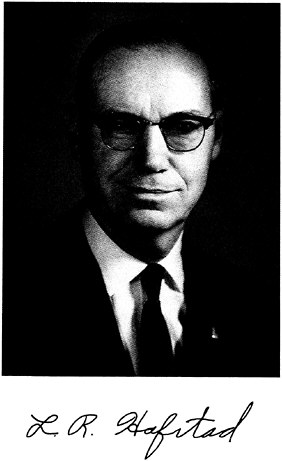LAWRENCE R. HAFSTAD
1904–1993
WRITTEN BY JOHN D. CAPLAN SUBMITTED BY THE NAE HOME SECRETARY
LAWRENCE R. HAFSTAD, whose five-decade career spanned basic physics research, government service, and industrial research management, died on October 12, 1993, at the age of eighty-nine
During his early career, Larry spent over ten years at the Carnegie Institution of Washington, where his research ranged from studies of the ionosphere to early experiments on light element disintegration.
In the second phase of his career, he devoted fifteen years to government service. These activities started with his work on antiaircraft weapons, proximity fuses for shells, and torpedo exploders for the Office of Scientific Research and Development. Larry then joined the Johns Hopkins Applied Physics Laboratory staff and became its director. Later he served as executive secretary of the Research and Development Board, Department of Defense. His final government assignment was as director of reactor development for the Atomic Energy Commission (AEC).
The next fifteen years of Larry's career were spent in the private sector. He was director of the Atomic Energy Division of the Chase Manhattan Bank for a brief period before becoming vice-president of General Motors Corporation (GM) in charge of corporate research laboratories. He retired from the latter position in May 1969. During this time, Larry continued his Washington interests, especially after 1962 when the GM
Defense Research Laboratories were organized and added to his responsibility.
Born June 18, 1904, in Minneapolis, the son of Norwegian immigrants, Larry worked his way through the University of Minnesota (B.S. in electrical engineering, 1926). Concurrently, he was employed as a maintenance engineer by Northwestern Bell Telephone Company and was elected president of the Minneapolis Inside Maintenance Workers Bargaining Committee. His graduate work in physics began at the University of Minnesota and culminated with a Ph.D. degree from the Johns Hopkins University in 1933.
Larry was, perhaps, best known professionally for his efforts in the peaceful uses of nuclear energy and especially the development of nuclear power plants. Although renowned for these efforts, Larry was particularly proud of three other accomplishments: his work with Merle A. Tuve and O. Dahl leading to the development of a million-volt vacuum tube, for which they received in 1931 the American Association for the Advancement of Science (AAAS) Prize (which became the AAAS Newcomb Cleveland Prize); the development of radio proximity fuses for bombs, rockets, and other military hardware in World War II; and the transformation of the General Motors Research Laboratory from a small automotive development laboratory to a major industrial research laboratory covering a wide range of sciences and technologies.
Larry was elected to the National Academy of Engineering (NAE) in 1968. For his work on military ordnance in World War II, he received the U.S. Navy Medal of Merit and the British King's Medal in Defense of Freedom. He was also a recipient of the Distinguished Service Award from both the Department of Defense (DOD) and the Atomic Energy Commission.
Larry remained active in government service after entering private industry both as a member and chairman of the AEC General Advisory Committee and as a member of the DOD Defense Science Board. He was a member of the NAE Committee on Public Engineering Policy and a member-at-large of the National Research Council (NRC) Division of Engineering. Larry's participation on NRC activities also included the
Executive Committee of the Division of Engineering, the Committee on Undersea Warfare and its Shipbuilding Study Group of the Division of Physical Sciences, the Special Committee on Long-Range Planning of the Highway Research Board, and the Advisory Committee for Study of Non-Rail Transit Vehicles of the Division of Engineering. After his retirement he remained active especially as chairman of the Committee on Undersea Warfare.
Past chairman of the Directors of Industrial Research, Larry also served as a trustee of the Johns Hopkins University, the Carnegie Endowment for International Peace, the MITRE Corporation, and the National Security and Industrial Association. He also served on the Board of Visitors of Tulane University, as chairman of the U.S. Naval Postgraduate School Visiting Committee, and as chairman of the Visiting Committee for Physical Sciences at Johns Hopkins. Larry received honorary awards from his alma mater, the University of Minnesota, the University of Michigan, and Stevens Institute of Technology.
Larry was an early disciple of a systems approach to technical development. He brought much of his enthusiasm for this to General Motors. The range of his eclectic interests continued during the three phases of his career. His thoughtful yet incisive analyses of programs permitted him to contribute to their progress, irrespective of the technical area. A quiet and somewhat reserved mien hid his ongoing interest in the education and development of young scientists and engineers.
Upon retirement Larry and his wife, Mary, and son, Bill, moved from Michigan to the countryside near Chester, Maryland, where they built a new retirement home. Mary predeceased Larry, and he spent his final years living with his son and his son's family in Oldwick, New Jersey.





